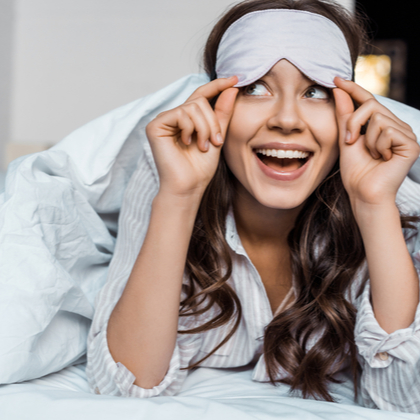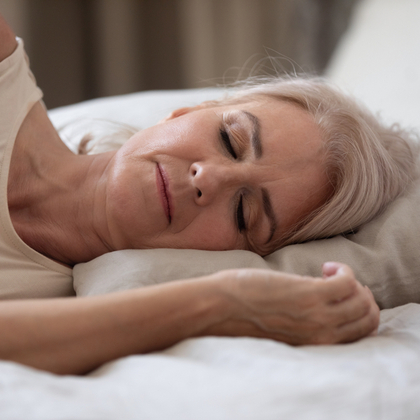
Sleep paralysis is an intriguing disorder that challenges our perception of wakefulness and sleep. During an episode, the brain becomes conscious and awake, while the rest of the body remains temporarily immobilised. Understandably, this can be stressful and frightening for those who experience it.
Sleep paralysis is different for everyone; its severity and length varies from person to person. Although it can be very unpleasant, it’s generally benign, short-lived, and a one-off occurrence.
Here, we explore the triggers and symptoms of sleep paralysis and outline some of the most effective management tools.
What is sleep paralysis?
Sleep paralysis is a disorder that occurs in REM (rapid eye movement) sleep. It typically happens soon after falling asleep, at some point during sleep, or just before a person’s usual time of awakening1.
Normal REM sleep involves dreaming and atonia – a temporary loss of muscle control –, which prevents you from acting out vivid dreams. In most instances, atonia stops as soon as you wake up, so you never become conscious of your inability to move.
Unusually, sleep paralysis comprises a mixed state of consciousness, merging REM sleep and wakefulness: atonia and vivid dreaming persist despite being awake and alert2.

Experts generally define sleep paralysis as a ‘parasomnia characterised by an inability to move and often accompanied by hallucinations of a sensed presence nearby’3. Parasomnias are unusual behaviours exhibited in sleep. And since this condition is known to occur in REM sleep, sleep paralysis is also referred to as REM parasomnia.
Sleep paralysis is more common among teenagers, young adults, and psychiatric patients, especially those with panic or post-traumatic stress disorders4.
What are the symptoms of sleep paralysis?
The most characteristic symptom of sleep paralysis is atonia or feeling temporarily paralysed, which typically occurs shortly after falling asleep or waking up5.
Hallucinations are another common symptom of sleep paralysis, affecting 75 per cent of episodes. Sleep paralysis hallucinations often occur when falling asleep (hypnagogic hallucinations) or waking up (hypnopompic hallucination)6. They may also vary depending on a person’s cultural identity7.
Most people report the following hallucinations during sleep paralysis:
-
Chest pressure hallucinations, which can make it hard to take full, deep inhalations as if your chest is being restricted or crushed.
-
Intruder hallucinations, involving a supernatural presence or intruder in the room (hearing noises, like footsteps, breathing, or shuffling, or seeing a human, animal, or monster). One study found that out of 185 patients suffering from sleep paralysis, 58% detected an evil presence in the room8..
-
Vestibular-motor (V-M) hallucinations, which may incite out of body sensations, such as floating or flying.
A sleep paralysis attack can last between a few seconds to several minutes, averaging between six and seven minutes9.
The combination of atonia and hallucinations can make sleep paralysis a particularly distressing and frightening experience. Although you’ll be able to speak and move normally afterwards, you may, understandably, be tense and uneasy about going to sleep again. If you feel anxious, you may want to try some of anxious, try some sleep-promoting relaxation exercises.
What triggers sleep paralysis?
Experts are unsure why REM sleep can occur during wakefulness and lead to sleep paralysis. Still, some theories have linked it to the following risk factors10:
-
Narcolepsy a chronic condition that causes individuals to experience sleep attacks, cataplexy (sudden loss of muscle tone), vivid hallucinations at sleep onset, and sleep paralysis11.
-
Irregular sleep patterns, due to shift work or jet lag.
-
Stress – some experts believe sleep paralysis coincides with periods of stress12.
-
Anxiety disorders, such as post-traumatic stress disorder, bipolar disorder, depression, and panic disorder13
-
Sleep deprivation or insomnia.
-
A family history of sleep paralysis.
However, with all of these risk factors, it remains unclear if sleep paralysis is the cause, effect, or operates in a bidirectional relationship. More comprehensive research is needed to better understand this aspect of the disorder.
How to manage and prevent sleep paralysis?
Although sleep paralysis can be a frightening experience, it’s not considered dangerous. In most cases, it’s an infrequent event that occurs in otherwise healthy individuals. But if you have occasional sleep paralysis, you can take measures to manage and prevent it.
-
Get enough sleep every night; give yourself a non-negotiable seven to nine-hour sleep opportunity window
-
Go to bed and wake up at roughly the same time every day, even at the weekends
-
Ensure your sleeping environment is temperate, quiet, and dark
-
Get plenty of regular exercise, but avoid physical activity after 7pm
-
Limit the use of alcohol and tobacco, and other stimulants before bed
-
Try to consume all caffeine before midday
-
Prioritise relaxation and mindfulness-based techniques, such as meditation, deep breathing, and visualisation, before bed
-
Disconnect from all technology and screens at least one hour before bed.
What is the treatment for sleep paralysis?
There’s limited information available on treating sleep paralysis. Ultimately, the most important step you can take is to maintain healthy sleep hygiene with the tips outlined above.
But if you’re experiencing sleep paralysis regularly or feel especially anxious about going to sleep, it’s a good idea to see your GP to discuss further management options.
In recent years, psychologists have developed a new form of cognitive behavioural therapy (CBT) for sleep paralysis14. However, more research is needed to corroborate its efficacy.
Additionally, some medications are known to suppress REM sleep, which may help recurrent sleep paralysis. But they can have side effects and shouldn’t be taken lightly, so you should always have a chat with your GP before starting any new medication.
Is it safe to wake someone from sleep paralysis?
It’s entirely safe to wake someone up from sleep paralysis. In fact, they will probably be hugely grateful. If you suspect your bed partner is experiencing sleep paralysis, you could try talking to them, tapping their shoulder, or gently shaking them.
When you’re in the throes of sleep paralysis, it can be terrifying. But it can be helpful to remind yourself that it’s a natural and temporary occurrence. Almost everyone will experience it at some point. And by focussing on good sleep hygiene practices, you can reduce the likelihood of this bothersome phenomenon.
To learn more about different sleep conditions and how to improve your sleep hygiene, please explore the rest of the articles on our Sleep Health Hub.
References:
- Girard. T. & Cheyne. J. (2006). Timing of spontaneous sleep-paralysis episodes. Journal of Sleep Research. 15(2), 222-229.
- Denis D. (2018) Relationships between sleep paralysis and sleep quality: current insights. Nat Sci Sleep. 10:355-367.
- Solomonova. E., Nielsen. T., Stenstrom. P., Simard. V., Frantova. E. & Donderi. D. (2008). Sensed presence as a correlate of sleep paralysis distress, social anxiety and waking state social imagery. Consciousness and Cognition. 17(1), 49-63.
- Sharpless. B. & Barber. J. (2011). Lifetime prevalence rates of sleep paralysis: A systematic review. Sleep Medicine Reviews. 15(5), 311-315.
- NHS UK. (2019). Sleep paralysis. Available online: https://www.nhs.uk/conditions/sleep-paralysis
- Denis D. (2018) Relationships between sleep paralysis and sleep quality: current insights. Nat Sci Sleep. 10:355-367.
- Olunu E, Kimo R, Onigbinde EO, Akpanobong MU, Enang IE, Osanakpo M, Monday IT, Otohinoyi DA, John Fakoya AO. (2018) Sleep Paralysis, a Medical Condition with a Diverse Cultural Interpretation. Int J Appl Basic Med Res. (3): 137-142.
- Sharpless. B. & Kliková. M. (2019). Clinical features of isolated sleep paralysis. Sleep Medicines. 58, 102-106.
- Sharpless BA. (2016) A clinician's guide to recurrent isolated sleep paralysis. Neuropsychiatr Dis Treat, 12: 1761-7.
- Cohut. M. (2019). Sleep paralysis: What is it, and how can you cope with it? Medical News Today. Available online: https://www.medicalnewstoday.com/articles/321569.php
- Denis. D., French. C. & Gregory. A. (2018). A systematic review of variables associated with sleep paralysis. Sleep Medicine Reviews. 38, 141-157.
- Lanese. N. (2019). Sleep Paralysis: Causes, Symptoms & Treatment. https://www.livescience.com/50876-sleep-paralysis.html
- Solomonova. E., Nielsen. T., Stenstrom. P., Simard. V., Frantova. E. & Donderi. D. (2008). Sensed presence as a correlate of sleep paralysis distress, social anxiety and waking state social imagery. Consciousness and Cognition. 17(1), 49-63.
- Denis D, French CC, Schneider MN, Gregory AM. (2018) Subjective sleep-related variables in those who have and have not experienced sleep paralysis. J Sleep Res. 27(5): e12650.
Related Posts

Olivia
Olivia Salter has always been an avid health nut. After graduating from the University of Bristol, she began working for a nutritional consultancy where she discovered her passion for all things wellness-related. There, she executed much of the company’s content marketing strategy and found her niche in health writing, publishing articles in Women’s Health, Mind Body Green, Thrive and Psychologies.
View More



